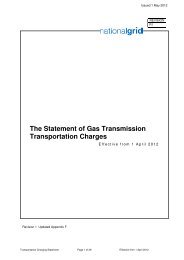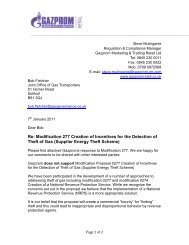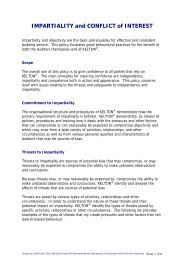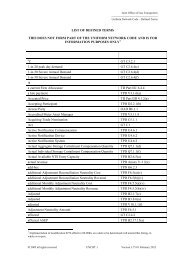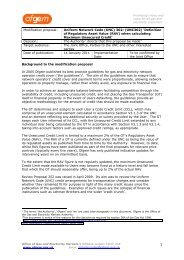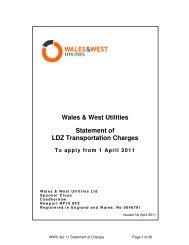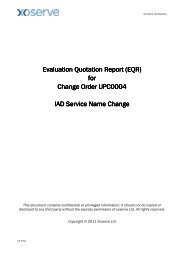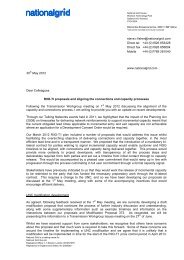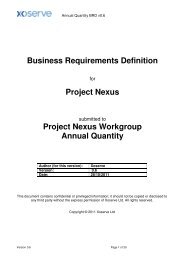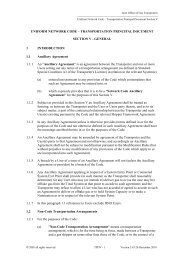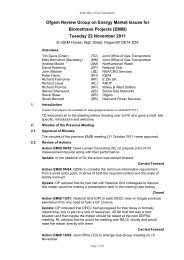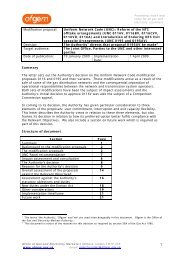Treatment of Entry/Exit capacity revenues under RIIO-T1 & NTS ...
Treatment of Entry/Exit capacity revenues under RIIO-T1 & NTS ...
Treatment of Entry/Exit capacity revenues under RIIO-T1 & NTS ...
You also want an ePaper? Increase the reach of your titles
YUMPU automatically turns print PDFs into web optimized ePapers that Google loves.
<strong>Treatment</strong> <strong>of</strong> <strong>Entry</strong>/<strong>Exit</strong> <strong>capacity</strong> <strong>revenues</strong> <strong>under</strong><br />
<strong>RIIO</strong>-<strong>T1</strong> & <strong>NTS</strong> Charging Methodology impacts<br />
Place your chosen<br />
image here. The four<br />
corners must just<br />
cover the arrow tips.<br />
For covers, the three<br />
pictures should be the<br />
same size and in a<br />
straight line.<br />
<strong>NTS</strong> CMF – 02 May 2013<br />
Richard Hounslea, National Grid <strong>NTS</strong>
Overview<br />
<strong>NTS</strong> <strong>Exit</strong> Capacity Charges<br />
<strong>RIIO</strong>-<strong>T1</strong> Licence <strong>Exit</strong> Capacity Terms<br />
Key changes <strong>under</strong> <strong>RIIO</strong>-<strong>T1</strong><br />
Key changes required for <strong>RIIO</strong>-<strong>T1</strong> <strong>Exit</strong> Capacity Charge<br />
setting<br />
<strong>Exit</strong> Capacity Charge Modelling (<strong>Exit</strong> Tariff Model)<br />
<strong>NTS</strong> <strong>Entry</strong> Capacity Charges<br />
<strong>RIIO</strong>-<strong>T1</strong> Licence <strong>Entry</strong> Capacity Terms<br />
Key changes required for <strong>RIIO</strong>-<strong>T1</strong><br />
<strong>Entry</strong> Capacity Charge setting<br />
Next Steps<br />
2
<strong>NTS</strong> <strong>Exit</strong> Capacity Charges<br />
Set to recover 50% <strong>of</strong> TO allowed revenue set by Price<br />
Control 1<br />
Administered <strong>capacity</strong> charges<br />
Charging base is derived from baseline <strong>capacity</strong> 2 at each exit point<br />
Charges are locational<br />
Vary by each exit point<br />
Relate to Long Run Marginal Costs (LRMCs) calculated by<br />
Transportation Model<br />
LRMCs are adjusted to recover target exit revenue from baseline<br />
<strong>capacity</strong> levels<br />
An <strong>under</strong>-recovery from firm exit <strong>capacity</strong> are recovered<br />
through TO exit commodity charges<br />
1 After deductions for DN Pensions Deficit & <strong>NTS</strong> Metering charges<br />
2 Special Condition C8E, Table 2, “<strong>NTS</strong> baseline exit flat <strong>capacity</strong>”<br />
3
<strong>RIIO</strong>-<strong>T1</strong> Licence <strong>Exit</strong> Capacity Terms<br />
Revenue in TO control<br />
(note on the day is in SO control)<br />
Revenue in SO control<br />
Legacy TO<br />
<strong>Exit</strong> Capacity<br />
(Table 10)<br />
Non-incremental<br />
Obligated<br />
<strong>Exit</strong> Capacity<br />
Substitution <strong>of</strong> unsold <strong>capacity</strong> between <strong>Exit</strong> Points (Table 9)<br />
Subject to Authority Approval<br />
* Special Condition 5G<br />
Licence Baseline<br />
<strong>Exit</strong> Capacity<br />
(Table 8)<br />
Obligated<br />
<strong>Exit</strong> Capacity<br />
Firm <strong>Exit</strong> Capacity<br />
Incremental<br />
Obligated<br />
<strong>Exit</strong> Capacity<br />
Incremental Obligated <strong>Exit</strong> Capacity release<br />
Subject to Authority Approval<br />
Released after<br />
1 st April 2013<br />
Trigger for <strong>Exit</strong><br />
Capacity Substitution<br />
Released after<br />
1 st April 2013<br />
Funded Incremental<br />
Obligated<br />
<strong>Exit</strong> Capacity<br />
Non-obligated<br />
<strong>Exit</strong> Capacity<br />
Released before<br />
1 st April 2013<br />
Legacy Incremental<br />
<strong>Exit</strong> Capacity<br />
(Table 10)<br />
Reclassification as “Non-incremental<br />
Obligated <strong>Exit</strong> Capacity” after 5 years<br />
4
Key changes <strong>under</strong> <strong>RIIO</strong>-<strong>T1</strong><br />
From 1 st April 2013<br />
Revenue from Non-incremental Obligated <strong>Entry</strong>/<strong>Exit</strong><br />
Capacity & Funded Incremental Obligated <strong>Entry</strong>/<strong>Exit</strong><br />
Capacity is treated as TO revenue within the Price<br />
Control formulae stated in the Licence 3 .<br />
Revenue from Legacy Incremental <strong>Entry</strong>/<strong>Exit</strong> Capacity is<br />
treated as SO revenue within the Price Control formulae<br />
stated in the Licence 4 .<br />
3 Special Condition 2A <strong>of</strong> the Licence.<br />
4 Special Condition 3A <strong>of</strong> the Licence.<br />
5
Key changes required for <strong>RIIO</strong>-<strong>T1</strong><br />
<strong>Exit</strong> Capacity Charge setting<br />
Majority <strong>of</strong> changes are to UNC TPD Y 2.5.3 “TO Revenue Recovery<br />
Adjustment”<br />
Other minor changes throughout Section Y to maintain consistency<br />
Charging base for <strong>NTS</strong> exit <strong>capacity</strong> charges will be;<br />
1. Non-incremental Obligated <strong>Exit</strong> Capacity<br />
Licence Baseline <strong>Exit</strong> Capacity 5<br />
Legacy TO <strong>Exit</strong> Capacity 6<br />
Adjusted for <strong>Exit</strong> Capacity Substitution 7<br />
2. Plus Funded Incremental Obligated <strong>Exit</strong> Capacity<br />
…at each exit point<br />
SO Capacity Revenue calculation is exit point price x quantity <strong>of</strong> Legacy<br />
Incremental <strong>Exit</strong> Capacity 8<br />
5 Special Condition 5G, Table 8<br />
6 Special Condition 5G, Table 10 after the “Applicable Date”<br />
7 Special Condition 5G, Table 9<br />
8 Special Condition 5G, Table 10 before the “Applicable Date”<br />
6
<strong>Exit</strong> Capacity Charge Modelling<br />
(<strong>Exit</strong> Tariff Model)<br />
<strong>Exit</strong> point pays <strong>capacity</strong> charges<br />
(treated as SO revenue). Any<br />
remaining revenue allowance not<br />
recovered through <strong>capacity</strong> charges<br />
will be recovered through SO<br />
Commodity charges.<br />
After the 5 year SO incentive period<br />
the incremental <strong>capacity</strong> is added to<br />
TO charging base. Capacity charge<br />
<strong>revenues</strong> treated as TO.<br />
TPCR-4<br />
Revenue (TO)<br />
Revenue (SO)<br />
Incremental<br />
Capacity in TO<br />
Charging<br />
Base?<br />
<strong>RIIO</strong>-<strong>T1</strong> T-2<br />
T-1<br />
T TOTEX allowance begins 2 years in<br />
Revenue (TO)<br />
Revenue (SO)<br />
Incremental<br />
Capacity in TO<br />
Charging Base?<br />
<br />
x<br />
x<br />
<br />
x<br />
x<br />
T<br />
x<br />
<br />
x<br />
<br />
x<br />
<br />
T+1<br />
x<br />
<br />
x<br />
T+2<br />
x<br />
<br />
x<br />
T+3<br />
x<br />
<br />
x<br />
T+4<br />
x<br />
<br />
x<br />
T+5<br />
<br />
x<br />
<br />
advance <strong>of</strong> <strong>capacity</strong> release.<br />
Allowance would be recovered from<br />
the community via increased TO exit<br />
<strong>capacity</strong> charges & adjustments to TO<br />
exit commodity charges up to year t.<br />
At year t the new Funded Incremental<br />
Obligated <strong>Exit</strong> Capacity would be<br />
included in the charging base and<br />
charges would begin to be collected<br />
from the exit point.<br />
7
<strong>NTS</strong> <strong>Entry</strong> Capacity Charges<br />
‘Aim’ to recover 50% <strong>of</strong> TO allowed revenue set by Price<br />
Control<br />
No adjustment for allowed revenue<br />
Reflects Long Run Marginal Costs (LRMCs) calculated by<br />
Transportation Model<br />
Charges are locational<br />
Vary by each exit point<br />
Revenue shortfall recovered through TO <strong>Entry</strong><br />
Commodity Charge<br />
8
<strong>RIIO</strong>-<strong>T1</strong> Licence <strong>Entry</strong> Capacity Terms<br />
Revenue in TO control<br />
(note on the day is in SO control)<br />
Revenue in SO control<br />
Legacy TO<br />
<strong>Entry</strong> Capacity<br />
(Table 8*)<br />
Substitution <strong>of</strong> unsold <strong>capacity</strong> between <strong>Entry</strong> Points (Table 7*)<br />
Subject to Authority Approval<br />
* Special Condition 5F<br />
Non-incremental<br />
Obligated<br />
<strong>Entry</strong> Capacity<br />
Licence Baseline<br />
<strong>Entry</strong> Capacity<br />
(Table 6*)<br />
Obligated<br />
<strong>Entry</strong> Capacity<br />
Firm <strong>Entry</strong> Capacity<br />
Incremental<br />
Obligated<br />
<strong>Entry</strong> Capacity<br />
Incremental Obligated <strong>Entry</strong> Capacity release<br />
Subject to Authority Approval<br />
Released after<br />
1 st April 2013<br />
Trigger for <strong>Entry</strong><br />
Capacity Substitution<br />
Released after<br />
1 st April 2013<br />
Funded Incremental<br />
Obligated<br />
<strong>Entry</strong> Capacity<br />
Non-Obligated<br />
<strong>Entry</strong> Capacity<br />
Released before<br />
1 st April 2013<br />
Legacy Incremental<br />
<strong>Entry</strong> Capacity<br />
(Table 8*)<br />
TPCR3 revenue driver<br />
incremental entry<br />
<strong>capacity</strong> until 1 April 2017<br />
TPCR4 revenue driver<br />
incremental entry <strong>capacity</strong> for<br />
first five years from release<br />
Reclassification as “Non-incremental<br />
Obligated <strong>Entry</strong> Capacity” after five years<br />
9
Key changes required for <strong>RIIO</strong>-<strong>T1</strong><br />
<strong>Entry</strong> Capacity Charge setting<br />
Majority <strong>of</strong> changes are to terminology used in UNC TPD Y 2.5.4 “The Tariff Model for<br />
Determination <strong>of</strong> <strong>NTS</strong> <strong>Entry</strong> Capacity Charges”<br />
Changes only to the <strong>capacity</strong> terms which make up the obligated entry <strong>capacity</strong> level used to<br />
generate LRMC based entry reserve prices<br />
Unlike <strong>Exit</strong>, there is no adjustment for allowed revenue therefore no charging base effects<br />
Other minor changes throughout Section Y to maintain consistency<br />
For existing entry points which have a zero baseline <strong>capacity</strong> level (as defined in the<br />
Licence), but where Legacy Incremental <strong>Entry</strong> Capacity 9 or Funded Incremental<br />
Obligated <strong>Entry</strong> Capacity has been sold in a previous auctions, the level <strong>of</strong> Legacy<br />
Incremental <strong>Entry</strong> Capacity or Funded Incremental Obligated <strong>Entry</strong> Capacity release<br />
within the Gas Year in question is used as the obligated entry <strong>capacity</strong> level. 10<br />
For new <strong>NTS</strong> <strong>Entry</strong> Points, where no Legacy Incremental <strong>Entry</strong> Capacity or Funded<br />
Incremental Obligated <strong>Entry</strong> Capacity has been sold the entry <strong>capacity</strong> reserve price<br />
is set at the transportation model derived annuitized long run marginal cost for the<br />
relevant entry point with that entry point flowing at the obligated level.<br />
SO Capacity Revenue calculation is entry point price x quantity <strong>of</strong> Legacy Incremental<br />
<strong>Entry</strong> Capacity<br />
9 Special Condition 5F, Table 8 up to “Applicable date”<br />
10 This equates to Non-incremental Obligated <strong>Entry</strong> Capacity plus Funded Incremental Obligated <strong>Entry</strong> Capacity plus Legacy Incremental <strong>Entry</strong> Capacity<br />
10
Next Steps<br />
The Modification is not urgent<br />
The Modification is required to fully align the <strong>NTS</strong><br />
Charging Methodology with <strong>RIIO</strong>-<strong>T1</strong><br />
National Grid intends to submit the Modification to the<br />
UNC Modification Panel on 20 th June 2013<br />
11



